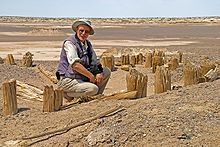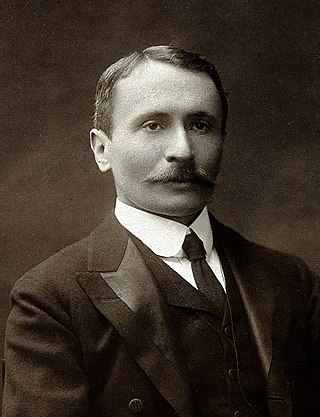
Sir Marc Aurel Stein, (Hungarian: Stein Márk Aurél; 26 November 1862 – 26 October 1943) was a Hungarian-born British archaeologist, primarily known for his explorations and archaeological discoveries in Central Asia. He was also a professor at Indian universities.

Lieutenant Colonel Sir Francis Edward Younghusband, was a British Army officer, explorer and spiritual writer. He is remembered for his travels in the Far East and Central Asia; especially the 1904 British expedition to Tibet, led by himself, and for his writings on Asia and foreign policy. Younghusband held positions including British commissioner to Tibet and president of the Royal Geographical Society.

The Taklamakan Desert is a desert in Southwestern Xinjiang in Northwest China. Located inside the Tarim Basin, it is bounded by the Kunlun Mountains to the south, the Pamir Mountains to the west, the Tian Shan range to the north, and the Gobi Desert to the east.

Sven Anders Hedin, KNO1kl RVO, was a Swedish geographer, topographer, explorer, photographer, travel writer and illustrator of his own works. During four expeditions to Central Asia, he made the Transhimalaya known in the West and located sources of the Brahmaputra, Indus and Sutlej Rivers. He also mapped lake Lop Nur, and the remains of cities, grave sites and the Great Wall of China in the deserts of the Tarim Basin. In his book Från pol till pol, Hedin describes a journey through Asia and Europe between the late 1880s and the early 1900s. While traveling, Hedin visited Turkey, the Caucasus, Tehran, Iraq, lands of the Kyrgyz people and the Russian Far East, India, China and Japan. The posthumous publication of his Central Asia Atlas marked the conclusion of his life's work.

The Tarim River, known in Sanskrit as the Śītā, is an endorheic river in Xinjiang, China. It is the principal river of the Tarim Basin, a desert region of Central Asia between the Tian Shan and Kunlun Mountains. The river historically terminated at Lop Nur, but today reaches no further than Taitema Lake before drying out.
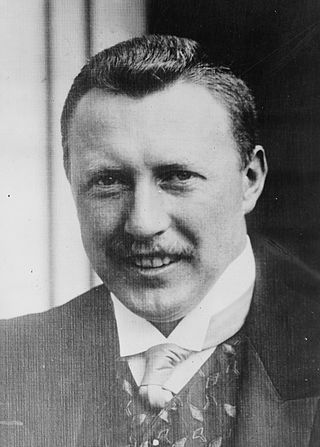
Wilhelm Filchner was a German army officer, scientist and explorer. He conducted several surveys and scientific investigations in China, Tibet and surrounding regions, and led the Second German Antarctic Expedition, 1911–13.

Hotan is a major oasis town in southwestern Xinjiang, an autonomous region in Western China. The city proper of Hotan broke off from the larger Hotan County to become an administrative area in its own right in August 1984. It is the seat of Hotan Prefecture.

Kucha, or Kuche, was an ancient Buddhist kingdom located on the branch of the Silk Road that ran along the northern edge of what is now the Taklamakan Desert in the Tarim Basin and south of the Muzat River.

Shanshan was a kingdom located at the north-eastern end of the Taklamakan Desert near the great, but now mostly dry, salt lake known as Lop Nur.

Loulan, also called Krorän or Kroraina, was an ancient kingdom based around an important oasis city along the Silk Road already known in the 2nd century BCE on the northeastern edge of the Lop Desert. The term Loulan is the Chinese transcription of the native name Krorän and is used to refer to the city near Lop Nur as well as the kingdom.
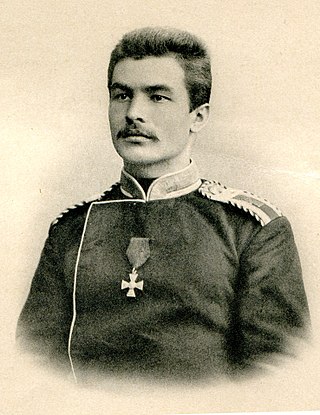
Pyotr Kuzmich Kozlov was a Russian and Soviet traveller and explorer who continued the studies of Nikolai Przhevalsky in Mongolia and Tibet.

Chaghaniyan, known as al-Saghaniyan in Arabic sources, was a medieval region and principality located on the right bank of the Oxus River, to the south of Samarkand.

The location of Tibet, deep in the Himalaya mountains, made travel to Tibet extraordinarily difficult at any time, in addition to the fact that it traditionally was forbidden to all western foreigners. The internal and external politics of Tibet, China, Bhutan, Assam, and the northern Indian kingdoms combined rendered entry into Tibet politically difficult for all Europeans. The combination of inaccessibility and political sensitivity made Tibet a mystery and a challenge for Europeans well into the 20th century.
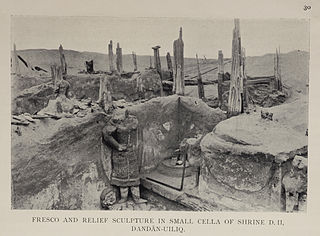
Dandan Oilik, also Dandān-Uiliq, lit. "the houses with ivory", is an abandoned historic oasis town and Buddhist site in the Taklamakan Desert of China, located to the northeast of Khotan in what is now the autonomous region of Xinjiang, between the Khotan and Keriya rivers. The central site covers an area of 4.5 km2; the greater oasis extends over an area of 22 km2. The site flourished from the sixth century as a site along the southern branch of the Silk Road until its abandonment before the Tibetan advance at the end of the eighth century.
Charklik or Charkhlik is an archeology site named after the town of Charkhlik (Qakilik), in Ruoqiang (Qakilik) County, Xinjiang Uyghur Autonomous Region of the People's Republic of China. Together with the nearby Miran site, they correspond to two ancient capitals of Shanshan, Wuni and Yixun. However, it is as yet unclear which site correspond to which capital.

The 1902 Ōtani expedition was a Japanese archaeological expedition to a series of Silk Road sites in the Taklamakan Desert, led by Count Ōtani Kōzui and lasting from 1902 until 1904. The expedition aimed to study the early transmission of Buddhism through Central Asia into China, and conducted major excavations in the Kucha area.

Mazar Tagh is the site of a ruined hill fort in the middle of the Taklamakan desert, dating from the time of the Tibetan Empire. Like the Miran fort site, its excavation has yielded hundreds of military documents from the 8th and 9th century, which are among the earliest surviving Tibetan manuscripts, and vital sources for understanding the early history of Tibet. The site is now located north of the modern city of Hotan in the Xinjiang Autonomous Region of the People's Republic of China.

Rawak is a Buddhist stupa located on the southern rim of the Taklamakan Desert in Xinjiang, China, along the famous trade route known as the Silk Road in the first millennium Kingdom of Khotan. Around the stupa there are other smaller structures which were originally decorated with a large number of colossal statues. The courtyard of the temple was surrounded by a wall, which contained terracotta relieves and some wall-paintings. The stupa and other structures form a three-dimensional mandala. The site is now about 40 km north of the modern city of Hotan in Xinjiang Autonomous Region, China.
Arthur Douglas Carey was a British civil servant in India, now remembered as a traveller in Central Asia, and in particular for exploration in what is now Xinjiang.
Through Asia Volume 1 is a travel book by the Swedish explorer Sven Hedin, which was published in 1898 by the British publishing house Methuen Publishing Ltd. Originally published in Swedish under the name, En Färd Genom Asien, the travel writing is an account of Hedin's first big expedition through Central Asia during the years 1893 to 1897. The first volume covers Hedin's records of his journey until June 1895. It contains multiple photographs and illustrations from sketches by the author.
